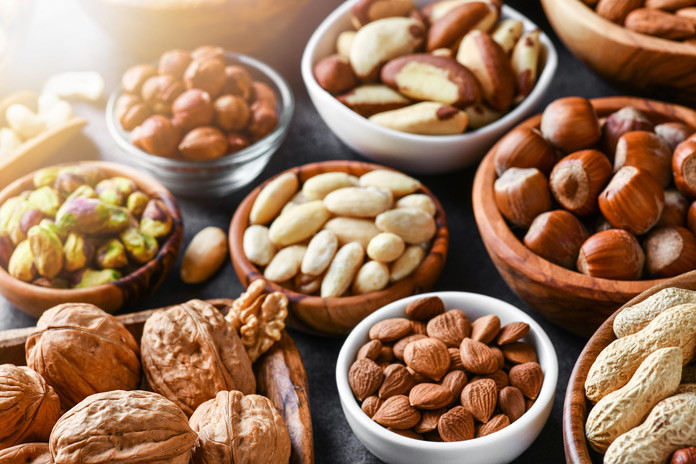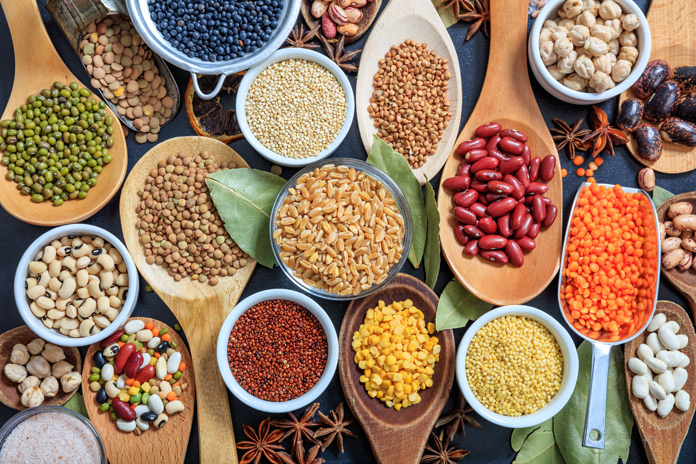As a vital trace element, zinc is involved in numerous metabolic and biological processes. Zinc deficiency can therefore have a variety of consequences.
Typical are skin problems, wound healing disorders, and increased susceptibility to infections. Read more about the symptoms, causes, and ways to treat or prevent zinc deficiency.
Definition
Zinc is one of the essential trace elements. Essential means: Zinc is vital, but the body cannot produce the substance itself. Zinc must therefore be supplied from outside, usually with food. Furthermore, there are no storage locations for the trace element in the organism. If less zinc is taken in than required, deficiency symptoms can result.
Zinc deficiency can cause many ailments, including skin blemishes and eczema, brittle hair and nails, poorly healing wounds, growth disorders, reproductive problems, or recurring infections.
This multitude of symptoms is due to the fact that zinc is involved in almost all biological processes in the body. The trace element is a component of many enzymes and plays a crucial role in the metabolism of proteins, carbohydrates, and fats.
In addition, zinc is significantly involved in the structure of cells, genetic material, and sex and thyroid hormones. In addition, healthy wound healing, a robust immune system, and the storage of the hormone-like substance insulin depend on an adequate supply of zinc.
It is therefore important to take in enough zinc. Here you can find out what you need to consider when taking zinc and how to prevent deficiency symptoms.
Requirement

Zinc requirements vary from person to person. It depends on age, gender, and previous illnesses and varies according to special life situations such as pregnancy and breastfeeding.
The current recommendations are now based on the intake of phytate – they are therefore dependent on nutrition. This has the following background: A high intake of phytate can reduce the bioavailability of zinc – by up to 45 percent.
Depending on the individually consumed amount of phytate (high, medium, low), women should take in between 7 and 10 mg and men between 11 and 16 mg of zinc per day. Until 2019, the standard values were 7 mg for women and 10 mg for men.
Phytate And Phytic Acid
Phytic acid is a secondary plant substance that stores minerals and trace elements such as phosphate, potassium, iron, magnesium, and calcium. Cereals (wheat, barley, and rye bran), legumes (soybeans, beans, chickpeas, lupins), and oilseeds (nuts) contain a particularly large amount of phytic acid.
Like plants, humans also need minerals and trace elements. These are ingested with food and absorbed in the small intestine. They are then available to the organism. This is where phytic acid or phytate comes into play.
Phytate is the anion of phytic acid. When this molecule encounters trace elements such as zinc, it binds them in the digestive tract. Once bound, zinc is no longer available to the organism.
Phytic acid or its salt phytate, therefore, reduces the proportion of zinc that can be utilized by the body. This effect can also be observed with other minerals, such as iron, magnesium, and calcium.
Recommended Zinc Intake
As already described, the reference values for the daily recommended zinc intake are based on the phytate intake. This is defined as follows:
High Phytate Intake
A high phytate intake (corresponding to a phytate intake of 990 mg/day or 1.5 mmol/day) is a diet in which large quantities of non-germinated or unfermented whole grain products (e.g. fresh grain porridge) and legumes (e.g. soy and kidney beans), but hardly any animal products are consumed. In this case, the phytate intake can be so high that zinc absorption is significantly impaired.
This effect can be lowered by preparation methods such as soaking, sprouting, or sourdough fermentation. In addition, the simultaneous intake of animal protein can increase the bioavailability of zinc.
Medium Phytate Intake
A wholesome diet that includes meat and/or fish as well as whole grain products and legumes as an average phytate intake (corresponding to a phytate intake of 660 mg/day or 1 mmol/day).
With this diet, sufficient zinc intake from food is guaranteed. This also applies to a vegetarian or vegan diet in which the grain products consist primarily of sourdough or ground flour (e.g. white flour) or sprouted grain.
Low Phytate Intake
A low phytate intake (corresponding to a phytate intake of 330 mg/day or 0.5 mmol/day) is given if few whole grain products and legumes are consumed and many animal products are eaten.
Zinc can then be used very well by the organism. However, this diet is judged to be nutritionally unfavorable. Without whole grain products and legumes, for example, the body lacks health-promoting dietary fiber.
Recommended Zinc Intake In mg/day For Adults

Recommended Zinc Intake In mg/day For Pregnant And Breastfeeding Women

The recommended zinc intake for children is independent of phytate intake. This is explained by the fact that no significant influence of phytate intake on zinc absorption was found in small children.
Recommended Zinc Intake In Mg/day For Children And Adolescents

Symptoms
Symptoms that can be traced back to a zinc deficiency are diverse. The following symptoms can indicate an insufficient supply of zinc:
General Symptoms
- Mood Swings
- Fatigue
- Weakness
- Lack Of Concentration
- Exhaustion And Depression
Skin, Hair And Nail Symptoms
- Wound Healing Disorders
- Dry Scaly Skin
- Inflammatory Skin Diseases (Zinc Deficiency Dermatitis: Skin Reddening And Pustules, Especially On The Face, And Fingers)
- Acne
- Eczema
- Psoriasis
- Hair Loss
- Brittle, Dull, And Thin Hair
- Brittle Nails
- White Spots On The Nails
Hormonal Symptoms
- Erectile Dysfunction
- Decreased Libido
- Infertility
- Elevated Blood Sugar Levels
- Growth And Developmental Disorders In Children And Adolescents
Impairments Of The Immune System
- Increased susceptibility to infection
- Frequent colds
- Increased infections and ulcers in the mouth such as herpes, aphthous ulcers, or inflammation of the oral mucosa
- Increased occurrence of skin fungi
Sense Organs
- Disorders of smell and taste
- Visual disturbances (such as sudden night blindness )
- Dry eyes
Although the symptoms mentioned can be signs of a zinc deficiency, they can also have other causes. A zinc deficiency can be assumed if the symptoms improve after the administration of zinc.
Causes
Nutrition
In many cases, the causes of zinc deficiency are diet-related. Above all, the western diet is based on industrially produced food, the so-called junk food. Although foods in this category have a high-calorie density, they contain few vital substances.
Diets, an unbalanced and one-sided diet, or eating disorders such as anorexia nervosa can also promote zinc deficiency.
In addition, vegetarians and vegans should pay attention to their zinc levels. Since the body can better utilize zinc from animal products than from plant products, an adequate intake of zinc-rich foods is crucial.
In addition, we often ingest substances that impede zinc utilization. Examples of this are the phytic acid already mentioned, but also phosphates from cola or lemonades as well as iron, copper, oxalates, and tannins from a wide variety of foods and luxury foods. In addition, calcium from milk and milk products can slow down zinc absorption.
Zinc Deficiency From Whole Grain Foods
Whole grain foods do not cause zinc deficiency per se. In addition to phytic acid, whole grain products contain more zinc than foods made from white flour. The DGE specifies the zinc content in wholemeal bread as 1.5 mg per 100 mg, in white bread, there is only just under 0.7 mg of zinc per 100 g. In addition, the bioavailability of zinc can be increased by soaking or sprouting legumes and sourdough fermentation in whole grain products.
Poor Zinc Utilization
In order for the body to be able to use zinc, the trace element must enter the bloodstream via the intestine. This process can be disturbed by various factors. These include chronic inflammatory bowel diseases (IBS) such as Crohn’s disease and ulcerative colitis, but also pancreatic diseases, liver dysfunction, and celiac disease (an intolerance to the sticky protein gluten).
Increased Zinc Requirement
In certain life situations, more zinc is required, for example in the growth and development phase, during pregnancy, in stressful situations, or in competitive athletes. The need for zinc also increases in the case of infectious diseases, cancer, or severe burns as well as nicotine and alcohol addiction.
Increased Zinc Loss
In some people, zinc is lost through urine or stool. For example, patients with diabetes, liver cirrhosis, and kidney disease can excrete an increased amount of zinc in the urine.
Certain drugs – for example, ACE inhibitors for high blood pressure, water tablets (diuretics), or cortisone – can also increase zinc excretion. In the case of persistent diarrhea or repeated use of laxatives, zinc is increasingly released through the stool.
Severe injuries or operations with high blood loss as well as unnoticed internal bleeding can also lead to a loss of zinc.
Treatment
Nutrition
If you suspect a zinc deficiency, you should first change your diet and ensure that you are getting enough zinc. We recommend a fresh and varied diet with a sufficiently high proportion of animal products.
Zinc-rich foods include:
- Red meats like beef and offal
- Fish and seafood
- Milk and milk products (do not take together with zinc preparations, as the calcium contained impairs zinc absorption in the intestine)
- Sourdough-based whole grain products
- Oil seeds such as sesame, poppy, pumpkin seeds, and sunflower seeds
- Nuts, especially peanuts, walnuts, and pecans
- Lentils, kidney beans, yellow peas, squash
Dietary Supplements
Sometimes an adjustment in the diet is not enough to remedy zinc deficiencies. Then zinc-containing medicines or dietary supplements can help to normalize the zinc level.
Corresponding preparations are available in different dosages and dosage forms – for example, gastric juice-protected tablets, coated tablets, capsules, or effervescent tablets.
Pay Attention To Good Tolerability And High Bioavailability
When choosing zinc-containing products, attention should be paid to good tolerability and high bioavailability. Stomach-friendly zinc preparations that reach the intestines intact are recommended.
Particularly efficient zinc absorption is achieved when the trace element is bound to an amino acid, in particular to methionine, cysteine, or histidine. Furthermore, zinc-aspartic acid compounds (zinc aspartate) are offered for zinc supplementation.
A few more tips for taking zinc:
- Zinc should preferably be taken on an empty stomach.
- After taking zinc supplements, it is recommended to abstain from food for an hour. In this way, you ensure sufficient zinc utilization.
- Iron reduces the absorption of zinc. Iron preparations should therefore be taken two to three hours after zinc intake.
- Patients with kidney, liver, intestinal or pancreatic problems, cancer, infectious diseases, or metabolic disorders should always consult a doctor before taking zinc.
Overdose
Zinc preparations should also not be taken thoughtlessly. Zinc poisoning is possible if too much zinc is consumed. This initially manifests itself in the form of a headache and a metallic taste in the mouth, as well as abdominal discomfort, nausea, vomiting, and diarrhea.
With a permanently increased zinc intake, serious complications such as anemia, neuromotor disorders, impaired immune defenses, and even coma are possible. In addition, too much zinc can promote a deficiency of copper, iron, chromium, or manganese.





